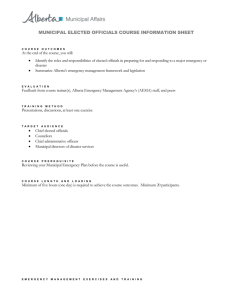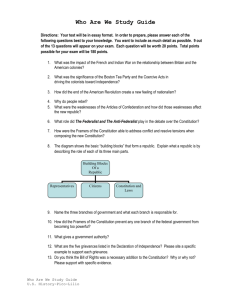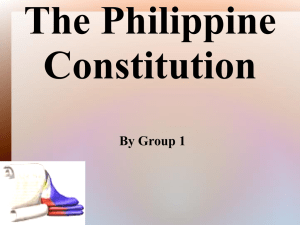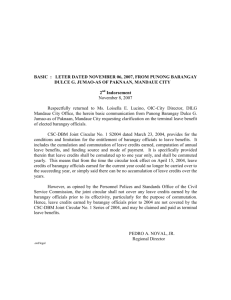Unit_2 - CLSU Open University
advertisement
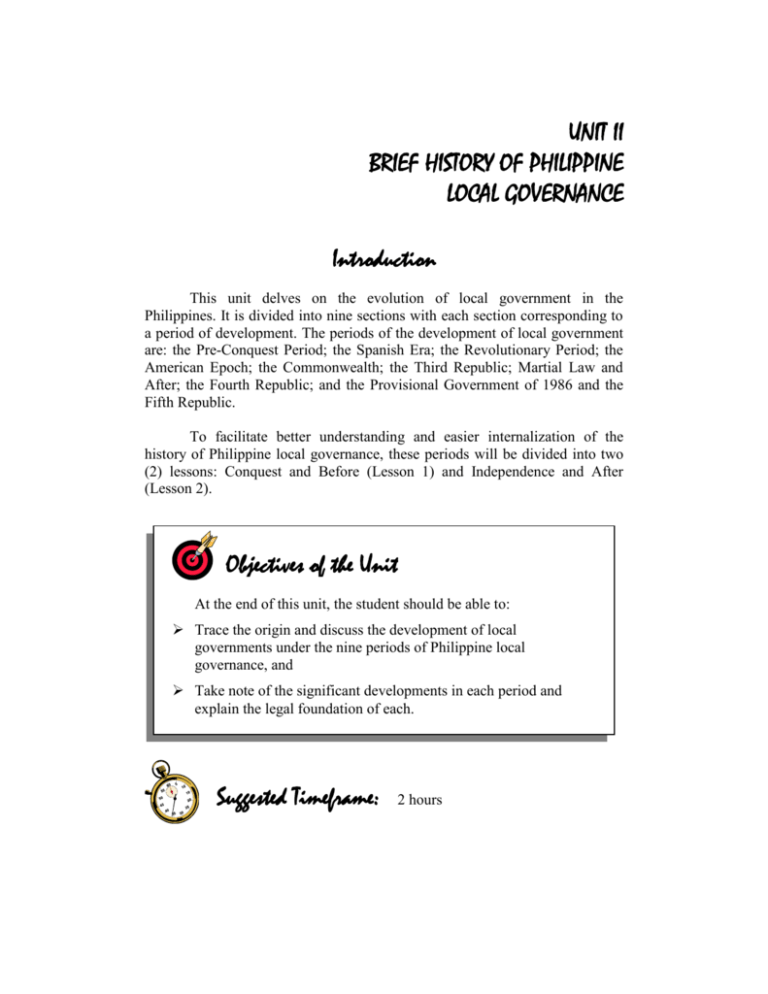
UNIT II BRIEF HISTORY OF PHILIPPINE LOCAL GOVERNANCE Introduction This unit delves on the evolution of local government in the Philippines. It is divided into nine sections with each section corresponding to a period of development. The periods of the development of local government are: the Pre-Conquest Period; the Spanish Era; the Revolutionary Period; the American Epoch; the Commonwealth; the Third Republic; Martial Law and After; the Fourth Republic; and the Provisional Government of 1986 and the Fifth Republic. To facilitate better understanding and easier internalization of the history of Philippine local governance, these periods will be divided into two (2) lessons: Conquest and Before (Lesson 1) and Independence and After (Lesson 2). Objectives of the Unit of the Unit should be able to: At theObjectives end of this unit, the student Trace the origin and discuss the development of local governments under the nine periods of Philippine local governance, and Take note of the significant developments in each period and explain the legal foundation of each. Suggested Timeframe: 2 hours 14 Lesson 1. Local Government During the Period of Conquest and Before Lesson 1 Objectives At the end of this lesson the student should be able to: 1. Discuss the history of local governance in the Philippines before the occupation and during the revolutionary, American, and Commonwealth periods; and 2. Enumerate the laws about local governance during these four (4) periods. Pre-Conquest Period Before the conquest of the Philippine islands in the middle of the sixteenth century and prior to the coming of Arab and Chinese traders and missionaries in the early 14th Century, there was already in existence a system of governance in the country known as the barangay. The term barangay was derived from “balangay” meaning the sailboats used by the Malays who fled the tyrannical rule of the Shri-Visjayan empire and settled in the southern part of the country (Arcellana 1969:39). The barangay was the political, economic and social organization of the Philippines. The barangays, which were the equivalent of the city-states of ancient Greece, had from 30 to 100 members composed mostly of kins whose relations were thing as popular suffrage as the inhabitants were not granted the right to choose their local officials, who were appointed by the central government. It was only toward the close of the Spanish regime that some political reforms were instituted. The Maura Law (1893), so called because it was authored by Antonio Maura y Montaner, Minister of Colonies, enfranchised local citizens within a limited degree, to select their officers, subject to strict supervision by insular authorities with very limited authority (Romani and Thomas 1954:120). Under the Maura Law, each town that contributed one thousand cedulas annually to the central government was allowed to have a municipal council of five members consisting of a municipal captain, chief lieutenant (teniente mayor), and three lieutenants. The law also provided for the election of 15 members of the council by a plurality vote. The municipal council prepared the municipal budget generated from real property taxes and from fees and tolls. The Revolutionary Period The Malolos Constitution of 1899 provided for a democratic system of local government specifically and essentially designed to encourage active participation by the people in the local affairs as a means of promoting national unity which was necessary at the time. The system of local government established by the Malolos Constitution was characterized by the following features, namely: 1) popular and direct election; 2) public sessions; 3) publication of budgets, accounts, and important ordinances; 4) intervention of the government and by the National Assembly, in appropriate cases, to prevent provinces and municipalities from performing acts in excess of their powers to the prejudice and detriment of the general welfare and individual interests; and 5) the determination of their taxing powers, in order that provincial and municipal taxation may never be antagonistic to the system of taxation of the state (cited by de Guzman, et. al., infra, quoting Art. 82, Title XI, Malolos Constitution of 1899). Each town had a set of officers composed of the chief of the town and the headman for each barrio and three officials, one each for the office of police and internal order, justice and civil registry, and taxes and property, elected by a majority vote of the inhabitants who have distinguished themselves by their high character, social position, and honorable conduct. The chief of the town, the headman of each barrio, and the three aforementioned officials constituted the popular assembly. The chief of the town served as president of the assembly; the headman, the vice president; and the justice and civil registry official, secretary of the assembly. The town chiefs, constituted into an assembly, elected the chief of the province and three councilors by a majority vote, the duties of whom correspond to those of the officials in the municipal level. The provincial council was composed of the chief of the province, as its president, and the chief of the capital town and the three officials, as members. The representatives of the province to the Revolutionary Congress were elected by the town chiefs by a majority vote. The American Epoch The system of government established in the Philippines by the American colonial masters was characterized by centralism. Local governments had very little control over local affairs. 16 The American colonial masters established the municipality. The first municipalities established had a municipal council composed of a President, who was its head, and the headmen of the barrios constituting the municipality. The Schurman Commission introduced the election, by word of mouth, of the President by the town residents. The election results, however, are to be approved by the American Commanding Officer of the town. Like the head of the municipal council under General Order No. 43 of 1899, the President was assisted by the heads of the composite villages. The acts of the municipal officials were subject to the absolute control of the American military officials, who were responsible only to the central government. The shift to civilian government sort of modified the highly centralized military government in the islands. That President McKinley intended to shed off some of the powers of the central government and give autonomy to local governments is evident in his Instruction of April 7, 1890. He specifically directed the Philippine Commission to establish: “… municipal government in which the natives of the islands… shall be afforded the opportunity to manage their own local affairs to the fullest extent of which they are capable, and subject to the least degree of supervision and control. In the distribution of power among the governments, the presumption is always to be in favor of the smaller subdivision, so that all the powers which can properly be exercised by the municipal government shall be vested in that government… (T)he central government… shall have no direct administration except in matters of a purely general concern and shall only have such supervision and control over the local government as may be necessary to serve and enforce faithful and efficient administration by local officials.” In accordance with and pursuant to the aforequoted instruction of President McKinley, the Philippine Commission enacted into law Act No. 82 and Act No. 83 which provided for the organization and government of municipalities and for the establishment of provinces, respectively. Under the first law, each municipality was headed by a President who was its chief executive. The other officials of the town are a Secretary, a Treasurer, and a Chief of Police. Each town had a council, which was the legislative body. The council had the President as its presiding officer with a representative each of the barrios comprising the town as members. Under Act No. 83, each provincial government had a Governor, who was the chief executive of the province and presiding officer of the provincial council, a Treasurer, and a Supervisor, who was later replaced by a Division 17 Superintendent of Schools. The Governor was elected, at first, by the councilors of the municipalities constituting the provinces and, later, by popular vote. No matter how good intentioned, the McKinley instructions were never realized due to the lack of capable local government officials, a situation which was the direct effect of the long domination of the local government units by the central government. Central control of local units was rationalized as it was necessary to control the numerous military struggles against the United States. The Commonwealth The approval and adoption of the 1935 Constitution paved the way for the institution of the Philippine Commonwealth. Under Sec. 10, Art. VII thereof, the President exercised general supervision over all local government units subject to the provisions of law, which power the President exercised through the Executive Bureau of the Department of Interior. Financial supervision over local governments was, however, later transferred to the Department of Finance. The Department of Interior was abolished in 1950 and was replaced by the Division of Local Government in the Office of the President of the Philippines. During this period, there was a shift towards centralization primarily due to the strong leadership of President Manuel L. Quezon who advocated for a strong central government with its chief executive exercising control over local units. City mayors were appointed by the President from 1936 to 1940. The police service was nationalized. The President had the power to define the boundaries of local government units as well as to merge and divide existing ones. 18 Lesson 2. Local Government During the Period of Independence and After Lesson 2 Objectives At the end of this lesson the student should be able to: 1. Discuss the development of local governance in the Philippines during the Third Republic, Martial Law and after, the Fourth Republic, and the Provisional Government of 1986 and the Fifth Republic; and 2. Explain the legal bases of the development of local governance during these periods. The Third Republic The declaration of Philippine independence in 1946 instituted the Third Republic of the Philippines with a unitary system of government. During this period there was a remarkable shift to decentralization. The momentum of decentralization was punctuated by the incorporation of one whole article on local government in the 1973 Constitution. There was a good number of pieces of legislation granting autonomy to local government units through the decentralization of more powers and a reduction of central control over local government. The more significant of these legislative enactments were Republic Act Numbered 2259, which made members of city councils such as mayors, vice mayors, and councilors elective. R.A. No. 2370, otherwise known as the Barrio Charter, later revised by R.A. No. 3590, which recognized the barrio as a legal entity and empowering its inhabitants to elect the barrio officials. R.A. No. 2264, popularly known as the Local Autonomy Act granted extensive taxing powers to local governments and the power to appropriate funds for the promotion of the general welfare, and R.A. No. 5185, otherwise known as the Decentralization Act of 1967 introduced some modifications in the spectrum of local governance. These innovations were, namely: the grant of authority to provincial and city governments to supplement national extension services; the surrender of control by the national government of certain local matters; increase in the share of provinces in internal revenue collections on the basis of population and land area; and transfer form the President to the provincial governor of the 19 power to appoint officials including, but not limited to, the provincial agriculturist and provincial assessor. Martial Law and After By virtue of Proclamation No. 1081 of September 21, 1972, the entire country was placed under Martial Law. At the time, the Constitutional Convention of 1971 was in the process of handcrafting a fundamental law for the land to replace the 1935 organic law. This basic law is now known in the annals of Philippine political history as the 1973 Constitution. Under the 1973 Constitution, the President was allowed to continue exercising legislative power, which covered the power to create, divide, merge, abolish, and alter the boundaries of local government units. With local elections suspended, the President also exercised the power to remove and appoint local officials, thereby drastically changing the entire picture of local governance. During the martial law regime, the barrio was renamed barangay and the council, sanggunian. Thus, the various local legislative councils metamorphosed to sanggunian. The provincial council, the city council, and the municipal council were renamed sangguniang panlalawigan, sangguniang panglungsod, and sangguniang bayan, respectively. The barangay council was renamed sangguniang barangay. A barangay justice system, more popularly called Katarungang Barangay, also dotted the political picture. During this period, citizen assemblies were created by virtue of P.D. No. 86, on December 31, 1972. A few days after, on January 5, 1973, the citizen assemblies metamorphosed to barangays through P.D. No. 86-A. On the third anniversary of the declaration of martial law, the barrios were declared as barangays. P.D. No. 826 renamed the provincial board and city and municipal boards of councils as sangguniang bayan. P.D. No. 877 of January 21, 1976 created the Katipunan ng mga Sanggunian, an umbrella organization of all the Sangguniang Bayan in the provinces and cities, including Metropolitan Manila. The Pampook na Katipunan ng mga Sanggunian was organized at the regional level in accordance with P.D. No. 925 of April 24, 1976. The PKS was composed of all the members of the Sangguniang Panlalawigan and Sangguniang Panglungsod and their presiding officers. Another political experiment of the martial law regime is the Kabataang Barangay, a youth organization. Formed through P.D. No. 684, dated April 15, 1975, the KB was composed of all barangay residents who are below 18 years of age but not lower than 15. The KB was administered by a 20 chairman with the assistance of 6 KB leaders chosen by the barangay youth assembly members from among themselves. The KB chairman was an exofficio member of the barangay council. In view of the KB chairman’s membership in the barangay council, the barangay captain exercised the power of general administrative supervision over the affairs of the youth organization. The President of the Philippines assumed and actually exercised the power of appointing local elective officials whose term of office expired on December 31, 1975. The exercise of the power to appoint local government officials was authorized by the people in a referendum held much earlier on February 27, 1975. With the election of provincial governors and city and municipal mayors on January 31, 1980, the election through popular suffrage of local officials with a fixed term of office was finally restored. The 1973 Constitution, so-called because it was considered ratified on January 17, 1973, recognized the significant role of local government in national development. It mandated the State to “guarantee and promote the autonomy of local government units, especially the barangays, to ensure their fullest development as self-reliant communities” (Sec. 10, Art. II). To encourage local governments to attain fiscal independence and sufficiency in consonance with the spirit of the abovementioned constitutional mandate, the 1973 Constitution empowered each local government to create its own sources of revenue and to define taxes that may be levied and to actually levy such taxes subject to such limitations as may be provided by law. Cognizant of the role of local governments in the solution of problems common to them, the 1973 Constitution encouraged local government units to group together, or consolidate or coordinate their efforts, services and resources for purposes commonly beneficial to them (Sec. 2, Art. IV). Under the 1973 Constitution, a local government unit may only be created, divided, merged, abolished or its boundary substantially altered with the approval of the majority of the votes cast in the unit or units affected (Sec. 3, Art. XI). Also under the 1973 Constitution, the State is mandated to enact into law a local government code with an effective system of recall (Sec. 2, Art. XI). The guarantee of local autonomy in the 1973 Constitution notwithstanding, the trends and developments that unfurled during the martial law regime pointed to the surrender of local autonomy and the concentration of authority to the central government which substantially diminished powers, functions, and responsibilities of the local government units. De Guzman and Reforma (1990), infra, enumerated six manifestations of increased central control over local matters, namely: (1) the exercise by the executive of legislative power which included the merger, creation, or abolition of local government entities; (2) expanded presidential power over local officials; (3) 21 nationalization of police; (4) exercise by the central government of the power to regulate infrastructures and establishments devoted to tourism promotion; (5) implementation of top-down approach in planning; and (6) the creation of too many and sometimes overlapping government offices that supervised different facets of local government affairs. The Fourth Republic The Fourth Republic was inaugurated on June 30, 1981, in accordance with the amendments introduced in 1981 to the 1973 Constitution following the lifting of martial law on January 17, 1981. The enactment of the Local Government Code (Batas Pambansa Blg. 337, February 10, 1983), constituted the most significant accomplishment of the New Republic pertaining to local government. Two other events marked the existence of the Fourth Republic, namely: the election of barangay officials on May 17, 1982 as prescribed by Batas Pambansa Blg. 222, of March 22, 1982, which completed the restoration of the election of local officials by direct popular suffrage, and conversion of the Ministry of Local Government and Community Development into a Ministry of Local Government. The former’s community development function was transferred to the Ministry of Human Settlements. The MLG had the mandate of developing the capability of local government officials and strengthening the administrative capability of local units (Sec. 4, E.O. 777). The Provisional Government of 1986 and the Fifth Republic Corazon C. Aquino was inducted into office on February 25, 1986 as President of the Philippines, replacing Ferdinand E. Marcos. On March 25 of the same year, President Aquino issued Proclamation No. 3 ushering in a provisional government which was revolutionary in nature. Proclamation No. 3 provided for a provisional Constitution, also known as the Freedom Constitution, which was in substance the 1973 Constitution. The ratification of the new Constitution on February 2, 1987 marked the coming into being of the Fifth Republic. The 1987 Constitution incorporates one whole article on local government which makes the provinces, cities, municipalities, and barangays as the territorial and political subdivisions of the Philippines and ordains the establishment of autonomous regions in Muslim Mindanao and the Cordilleras (Sec. 1, Art. X). The most 22 significant provision of Article X is Section 2 which proclaims that the political subdivisions of the country shall enjoy autonomy. Furthermore, Sec. 3 thereof mandates the enactment by Congress of a Local Government Code. Pursuant to and in compliance with aforesaid constitutional mandate, Congress enacted R.A. No. 7160 on October 10, 1991 providing for a Local Government Code. The LGC or Code, for brevity, has been undergoing implementation, thereafter. Activity Below is a three-column table. On the first column, you write nine (9) periods of the development of Philippine local governance. On second column, write two significant events corresponding to each period indicate the basis of each significant event or development in the column. the the and last After accomplishing the task, tear/cut off the page containing the table and submit it to your tutor for evaluation. Be sure that you have written your name on it. Periods of Philippine Local Governance Two (2) Significant Events Legal Bases of Significant Events 23 Unit Summary This unit has provided you with historical perspectives on the development of local governments in the Philippines. Particularly, it has presented the history of local governance in the Philippines under nine (9) periods. It also has emphasized the legal and constitutional bases of important events in these periods. You may now proceed to tackle the next unit.

